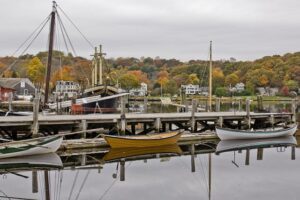 Middle Wharf is an example of a wooden pier, which was easy to build, but far less durable than a stone structure like the Museum’s Chubb’s Wharf. A pier like this is subject to the effects of the same wood-consuming creatures that deteriorate wooden vessels, as a display panel on the wharf makes clear. Wood-eating gribbles eat away wood around the waterline, giving an hourglass shape to the pilings. Now that the Mystic River is so clean, boring shipworms (actually related to clams) burrow into our ships and pilings, gradually destroying them.
Middle Wharf is an example of a wooden pier, which was easy to build, but far less durable than a stone structure like the Museum’s Chubb’s Wharf. A pier like this is subject to the effects of the same wood-consuming creatures that deteriorate wooden vessels, as a display panel on the wharf makes clear. Wood-eating gribbles eat away wood around the waterline, giving an hourglass shape to the pilings. Now that the Mystic River is so clean, boring shipworms (actually related to clams) burrow into our ships and pilings, gradually destroying them.
Middle Wharf is a good place to observe the birds of the Mystic River. Some, including the mallard, double-crested cormorant, herring gull, and osprey, are native to the area and are an important part of the larger marine environment. Others–including the rock dove (pigeon), introduced in the 1600s; house sparrow, introduced in the 1850s; starling, introduced in the 1890s; and mute swan, also introduced in the 1890s–were carried across the ocean as immigrants and have flourished in their new environment, sometimes displacing native species.


